Egyptian pyramids
Egyptian pyramids
From Wikipedia, the free encyclopedia
Unicode: 𓍋𓅓𓂋𓉴 | ||||
| Pyramid in hieroglyphs |
|---|
As of November 2008, there are sources citing both 118 and 138 as the number of identified Egyptian pyramids.[1][2] Most were built as tombs for the country's pharaohs and their consorts during the Old and Middle Kingdom periods.[3][4][5]
The earliest known Egyptian pyramids are found at Saqqara, northwest of Memphis. The earliest among these is the Pyramid of Djoser (constructed 2630 BC–2611 BC) which was built during the third dynasty. This pyramid and its surrounding complex were designed by the architect Imhotep, and are generally considered to be the world's oldest monumental structures constructed of dressed masonry.[6]
The most famous Egyptian pyramids are those found at Giza, on the outskirts of Cairo. Several of the Giza pyramids are counted among the largest structures ever built.[7] The Pyramid of Khufu at Giza is the largest Egyptian pyramid. It is the only one of the Seven Wonders of the Ancient World still in existence.
Contents
[hide]Historical development
By the time of the early dynastic period of Egyptian history, those with sufficient means were buried in bench-like structures known asmastabas.[8][9]
The second historically documented Egyptian pyramid is attributed to the architect Imhotep, who planned what Egyptologists believe to be a tomb for the pharaoh Djoser. Imhotep is credited with being the first to conceive the notion of stacking mastabas on top of each other, creating an edifice composed of a number of "steps" that decreased in size towards its apex. The result was the Step Pyramid of Djoserwhich was designed to serve as a gigantic stairway by which the soul of the deceased pharaoh could ascend to the heavens. Such was the importance of Imhotep's achievement that he was deified by later Egyptians.[10]
The most prolific pyramid-building phase coincided with the greatest degree of absolutist pharaonic rule. It was during this time that the most famous pyramids, those near Giza, were built. Over time, as authority became less centralized, the ability and willingness to harness the resources required for construction on a massive scale decreased, and later pyramids were smaller, less well-built and often hastily constructed.
Long after the end of Egypt's own pyramid-building period, a burst of pyramid-building occurred in what is present-day Sudan, after much of Egypt came under the rule of the Kings of Napata. While Napatan rule was brief and ceased in 661 BC, the Egyptian influence made an indelible impression, and during the later Sudanese Kingdom of Meroe(approximately in the period between 300 BC – AD 300) this flowered into a full-blown pyramid-building revival, which saw more than two hundred indigenous, but Egyptian-inspired royal pyramid-tombs constructed in the vicinity of the kingdom's capital cities.
Al-Aziz Uthman (1171–1198) tried to destroy the pyramids at Giza. He gave up after damaging the Pyramid of Menkaure, as the task proved too huge.[11]
Pyramid symbolism
The shape of Egyptian pyramids is thought to represent the primordial mound from which the Egyptians believed the earth was created. The shape of a pyramid is thought to be representative of the descending rays of the sun, and most pyramids were faced with polished, highly reflective white limestone, in order to give them a brilliant appearance when viewed from a distance. Pyramids were often also named in ways that referred to solar luminescence. For example, the formal name of the Bent Pyramid at Dahshur The Southern Shining Pyramid, and that of Senwosret at el-Lahun was Senwosret is Shining.
While it is generally agreed that pyramids were burial monuments, there is continued disagreement on the particular theological principles that might have given rise to them. One suggestion is that they were designed as a type of "resurrection machine."[12]
The Egyptians believed the dark area of the night sky around which the stars appear to revolve was the physical gateway into the heavens. One of the narrow shafts that extends from the main burial chamber through the entire body of the Great Pyramid points directly towards the center of this part of the sky. This suggests the pyramid may have been designed to serve as a means to magically launch the deceased pharaoh's soul directly into the abode of the gods.[12]
All Egyptian pyramids were built on the west bank of the Nile, which as the site of the setting sun was associated with the realm of the dead in Egyptian mythology.[13]
Number and location of pyramids
In 1842 Karl Richard Lepsius produced the first modern list of pyramids – see Lepsius list of pyramids – in which he counted 67. A great many more have since been discovered. As of November 2008, 118 Egyptian pyramids have been identified.[3]
The location of Pyramid 29, which Lepsius called the "Headless Pyramid", was lost for a second time when the structure was buried by desert sands subsequent to Lepsius' survey. It was only found again during an archaeological dig conducted in 2008.[14]
Many pyramids are in a poor state of preservation or buried by desert sands. If visible at all they may appear as little more than mounds of rubble. As a consequence archaeologists are continuing to identify and study previously unknown pyramid structures.
The most recent pyramid to be discovered is that of Queen Sesheshet, mother of 6th Dynasty Pharaoh Teti, located at Saqqara. The discovery was announced by Zahi Hawass, Secretary General of the Egyptian Supreme Council of Antiquities, on 11 November 2008.[4][15]
All of Egypt's pyramids, except the small Third Dynasty pyramid of Zawyet el-Amwat (or Zawyet el-Mayitin), are sited on the west bank of the Nile, and most are grouped together in a number of pyramid fields. The most important of these are listed geographically, from north to south, below.
Abu Rawash
Main article: Abu Rawash
Abu Rawash is the site of Egypt's most northerly pyramid (other than the ruins of Lepsius pyramid number one)[5]— the mostly ruinedPyramid of Djedefre, son and successor of Khufu. Originally it was thought that this pyramid had never been completed, but the current archaeological consensus is that not only was it completed, but that it was originally about the same size as the Pyramid of Menkaure, which would have placed it among the half-dozen or so largest pyramids in Egypt.
Its location adjacent to a major crossroads made it an easy source of stone. Quarrying – which began in Roman times – has left little apart from about 15 courses of stone superimposed upon the natural hillock that formed part of the pyramid's core. A small adjacent satellite pyramid is in a better state of preservation.
Giza
Main article: Giza pyramid complex
Giza is the location of the Pyramid of Khufu (also known as the "Great Pyramid" and the "Pyramid of Cheops"); the somewhat smaller Pyramid of Khafre (or Kephren); the relatively modest-sized Pyramid of Menkaure (or Mykerinus), along with a number of smaller satellite edifices known as "Queen's pyramids"; and the Great Sphinx.
Of the three, only Khafre's pyramid retains part of its original polished limestone casing, near its apex. This pyramid appears larger than the adjacent Khufu pyramid by virtue of its more elevated location, and the steeper angle of inclination of its construction – it is, in fact, smaller in both height and volume.
The Giza Necropolis has been a popular tourist destination since antiquity, and was popularized in Hellenistic times when the Great Pyramid was listed by Antipater of Sidon as one of the Seven Wonders of the World. Today it is the only one of those wonders still in existence.
Zawyet el-Aryan
See also: Zawyet el'Aryan
This site, halfway between Giza and Abu Sir, is the location for two unfinished Old Kingdom pyramids. The northern structure's owner is believed to be pharaoh Nebka, while the southern structure, known as the Layer Pyramid, may be attributable to the Third Dynasty pharaoh Khaba, a close successor of Sekhemkhet. If this attribution is correct, Khaba's short reign could explains the seemingly unfinished state of this step pyramid. Today it stands around 17 m (56 ft) high; had it been completed it is likely to have exceeded 40 m (130 ft).
Abu Sir
Main article: Abusir
There are a total of fourteen pyramids at this site, which served as the main royal necropolis during the Fifth Dynasty. The quality of construction of the Abu Sir pyramids is inferior to those of the Fourth Dynasty – perhaps signaling a decrease in royal power or a less vibrant economy. They are smaller than their predecessors, and are built of low-quality local limestone.
The three major pyramids are those of Niuserre, which is also the best preserved, Neferirkare Kakai and Sahure. The site is also home to the incomplete Pyramid of Neferefre. Most of the major pyramids at Abu Sir were built similar construction techniques, comprising a rubble core surrounded by steps of mud bricks with a limestone outer casing. The largest of these 5th Dynasty pyramids, the Pyramid of Neferirkare Kakai, is believed to have originally been built as a step pyramid some 70 m (230 ft) high and then later transformed into a "true" pyramid by having its steps filled in with loose masonry.
Saqqara
Main article: Saqqara
Major pyramids located here include the Step Pyramid of Djoser – generally identified as the world's oldest substantial monumental structure to be built of dressed stone – the Pyramid of Userkaf, the Pyramid of Teti and the Pyramid of Merikare, dating to the First Intermediate Period. Also at Saqqara is the Pyramid of Unas, which retains a pyramid causeway that is one of the best-preserved in Egypt. Together with the pyramid of Userkaf, this pyramid was the subject of one of the earliest known restoration attempts, conducted byKhaemweset, a son of Ramesses II.[16] Saqqara is also the location of the incomplete step pyramid of Djoser's successor Sekhemkhet, known as the Buried Pyramid. Archaeologists believe that had this pyramid been completed, it would have been larger than Djoser's.
South of the main pyramid field at Saqqara is a second collection of later, smaller pyramids, including those of Pepi I, Isesi, Merenre, Pepi II and Ibi. Most of these are in a poor state of preservation.
The Fourth Dynasty pharaoh Shepseskaf either did not share an interest in, or have the capacity to undertake pyramid construction like his predecessors. His tomb, which is also sited at south Saqqara was instead built as an unusually large mastaba and offering temple complex. It is commonly known as the Mastaba of Faraoun.[17]
A previously unknown pyramid was discovered at north Saqqara in late 2008. It is believed to be the tomb of Teti's mother, it currently stands approximately 5 m (16 ft) high, although the original height was closer to 14 m (46 ft).
Dahshur
Main article: Dahshur
This area is arguably the most important pyramid field in Egypt outside Giza and Saqqara, although until 1996 the site was inaccessible due to its location within a military base, and was relatively unknown outside archaeological circles.
The southern Pyramid of Snofru, commonly known as the Bent Pyramid, is believed to be the first Egyptian pyramid intended by its builders to be a "true" smooth-sided pyramid from the outset; the earlier pyramid at Meidum had smooth sides in its finished state – but it was conceived and built as a step pyramid, before having its steps filled in and concealed beneath a smooth outer casing of dressed stone.
As a true smooth-sided structure, the Bent Pyramid was only a partial success – albeit a unique, visually imposing one; it is also the only major Egyptian pyramid to retain a significant proportion of its original smooth outer limestone casing intact. As such it serves as the best contemporary example of how the ancient Egyptians intended their pyramids to look.
Several kilometeres to the north of the Bent Pyramid is the last – and most successful – of the three pyramids constructed during the reign of Snofru; the Red Pyramid is the world's first successfully completed smooth-sided pyramid. The structure is also the third largest pyramid in Egypt – after the pyramids of Khufuand Khafre at Giza.
Also at Dahshur is the pyramid known as the Black Pyramid of Amenemhet III, as well as a number of small, mostly ruined subsidiary pyramids.
Mazghuna
Main article: Mazghuna
Located to the south of Dahshur, several mudbrick pyramids were built in this area in the late Middle Kingdom, perhaps for Amenemhat IV and Sobekneferu.
Lisht
Main article: el-Lisht
Two major pyramids are known to have been built at Lisht – those of Amenemhat I and his son, Senusret I. The latter is surrounded by the ruins of ten smaller subsidiary pyramids. One of these subsidiary pyramids is known to be that of Amenemhat's cousin, Khaba II.[18]The site which is in the vicinity of the oasis of Fayyum, midway between Dahshur and Meidum, and about 100 kilometres south of Cairo, is believed to be in the vicinity of the ancient city of Itjtawy (the precise location of which remains unknown), which served as the capital of Egypt during the 12th Dynasty.
Meidum
Main article: Meidum
The pyramid at Meidum is one of three constructed during the reign of Sneferu, and is believed by some to have been started by that pharaoh's father and predecessor, Huni. However, that attribution is uncertain, as no record of Huni's name has been found at the site.
It was constructed as a step pyramid, and then later converted into the first "true" smooth-sided pyramid when the steps were filled in, and an outer casing added.
The pyramid suffered several catastrophic collapses in ancient and medieval times; medieval Arab writers described it as having seven steps – although today only the three uppermost of these remain, giving the structure its odd, tower-like appearance. The hill on which the pyramid is situated is not a natural landscape feature – it is the small mountain of debris created when the lower courses and outer casing of the pyramid gave way.
Hawara
Main article: Hawara
Amenemhet III was the last powerful ruler of the 12th Dynasty, and the pyramid he built at Hawarra, near Faiyum, is believed to post-date the so-called "Black Pyramid" built by the same ruler at Dahshur. It is the Hawarra pyramid that is believed to have been Amenemhet's final resting place.
el-Lahun
Main article: el-Lahun
The pyramid of Senusret II at el-Lahun is the southernmost royal-tomb pyramid structure in Egypt. Its builders reduced the amount of work necessary to construct it by ingeniously using as its foundation and core a 12-meter-high natural limestone hill.
El-Kurru
Main article: El-Kurru
Piye, the first ruler of the Egyptian 25th dynasty, built a pyramid at El-Kurru. He was the first Egyptian pharaoh to be buried in a pyramid in centuries.
Nuri
Main article: Nuri
Taharqa, a legitimate ruler and Pharaoh of Egypt, built his pyramid at Nuri. It was the largest in the area (North Sudan).
Construction dates
The following table lays out the chronology of the construction of most of the major pyramids mentioned here. Each pyramid is identified through the pharaoh who ordered it built, their approximate reign and its location.
| Pyramid / Pharaoh | Reign | Field |
|---|---|---|
| Djoser | c. 2670 BC | Saqqara |
| Sneferu | c. 2612–2589 BC | Dashur |
| Sneferu | c. 2612–2589 BC | Meidum |
| Khufu | c. 2589–2566 BC | Giza |
| Djedefre | c. 2566–2558 BC | Abu Rawash |
| Khafre | c. 2558–2532 BC | Giza |
| Menkaure | c. 2532–2504 BC | Giza |
| Userkaf | c. 2494–2487 BC | Saqqara |
| Sahure | c. 2487–2477 BC | Abu Sir |
| Neferirkare Kakai | c. 2477–2467 BC | Abu Sir |
| Nyuserre Ini | c. 2416–2392 BC | Abu Sir |
| Amenemhat I | c. 1991–1962 BC | Lisht |
| Senusret I | c. 1971–1926 BC | Lisht |
| Senusret II | c. 1897–1878 BC | el-Lahun |
| Amenemhat III | c. 1860–1814 BC | Hawara |
| Khendjer | c. 1764–1759 BC | Saqqara |
| Piye | c. 721 BC | El-Kurru |
| Taharqa | c. 664 BC | Nuri |
Construction techniques
Main article: Egyptian pyramid construction techniques
Constructing the pyramids involved moving huge quantities of stone. The quarried blocks were likely transported to the construction site by wooden sleds, with sand in front of the sled wetted to reduce friction. Droplets of water created bridges between the grains of sand, which helped them stick together.[20]
See also
- Egyptian pyramid construction techniques
- Pyramidion
- Ziggurat
- Al Ahram, Arabic for "the pyramids", name of Egyptian newspaper
List
References
- ^ Slackman, Michael (17 November 2008). "In the Shadow of a Long Past, Patiently Awaiting the Future". The New York Times. Retrieved 1 May 2010.
- ^ Mark Lehner (2008). The Complete Pyramids: Solving the Ancient Mysteries. p. 34.Thames & Hudson. 2008-03-25. ISBN 978-0-500-28547-3.
- ^ a b "Egypt says has found pyramid built for ancient queen". Reuters. Retrieved18 November 2008.
The pyramid, which Hawass said was the 118th found in Egypt, was uncovered near the world's oldest pyramid at Saqqara, a burial ground for the rulers of ancient Egypt.
- ^ a b Slackman, Michael (16 November 2007). "In the Shadow of a Long Past, Patiently Awaiting the Future". New York Times. Retrieved 17 November 2008.
Deep below the Egyptian desert, archaeologists have found evidence of yet another pyramid, this one constructed 4,300 years ago to store the remains of a pharaoh’s mother. That makes 138 pyramids discovered here so far, and officials say they expect to find more.
- ^ a b Michael Ritter (2003) [1] Dating the Pyramids. Retrieved 13 April 2005
- ^ Lehner, Mark (1997). The Complete Pyramids. New York: Thames and Hudson. p. 84.ISBN 978-0-500-05084-2.
- ^ Watkin, David (2005). A History of Western Architecture (4th ed.). Laurence King Publishing. p. 14. ISBN 978-1-85669-459-9."The Great Pyramid...is still one of the largest structures ever raised by man, its plan twice the size of St. Peter's in Rome"
- ^ [2] Burial customs: mastabas. University College London (2001) Retrieved 14 April 2005
- ^ "Early Dynastic burial customs". Digitalegypt.ucl.ac.uk. Retrieved 2012-11-16.
- ^ Quirke, Stephen (2001). The Cult of Ra: Sun Worship in Ancient Egypt. Thames & Hudson, pp. 118–120.
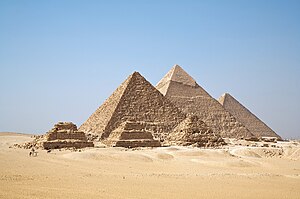

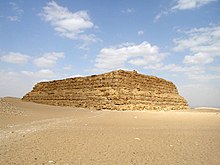
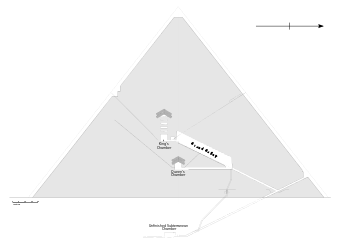



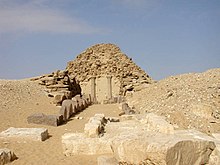

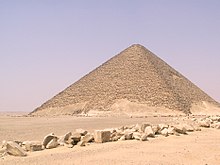





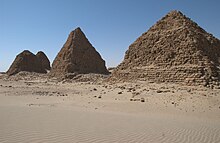


تعليقات
إرسال تعليق